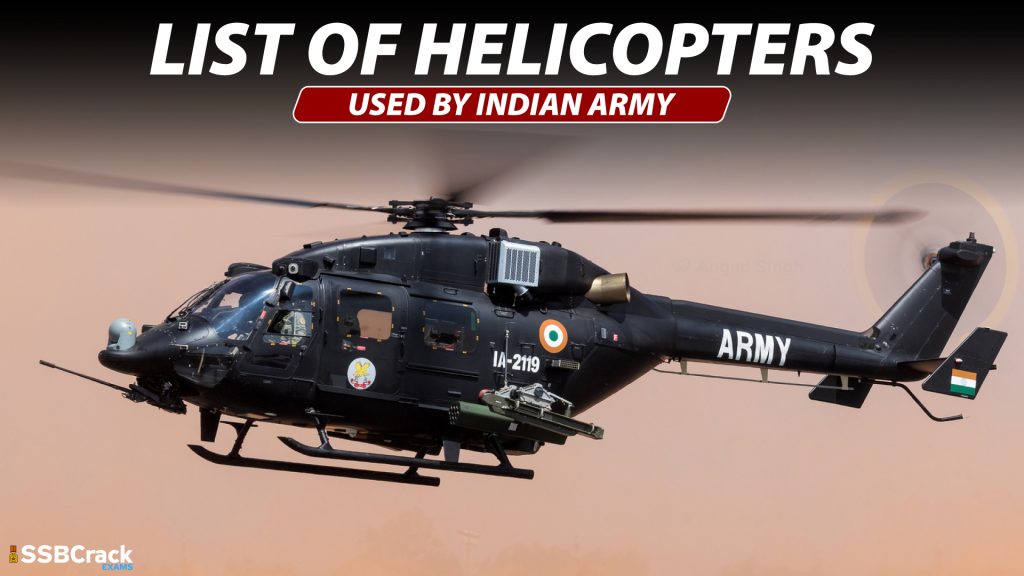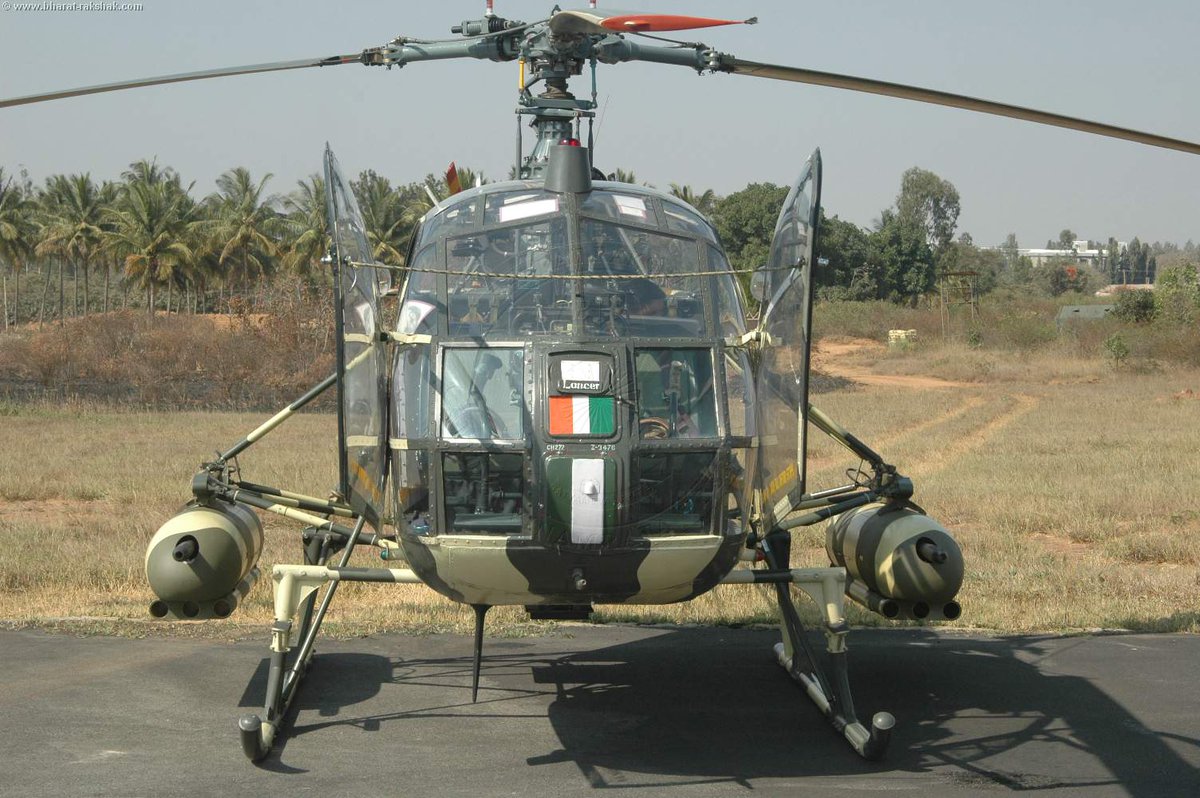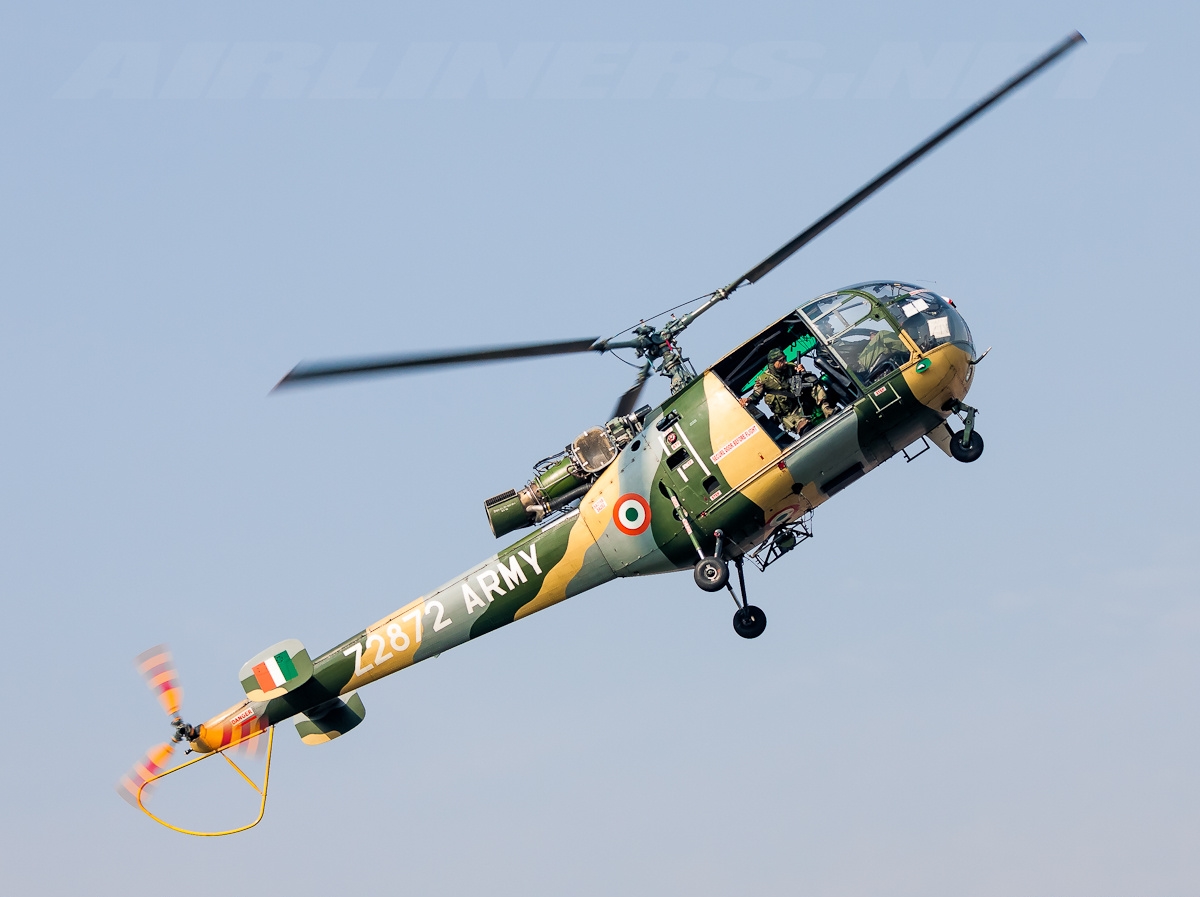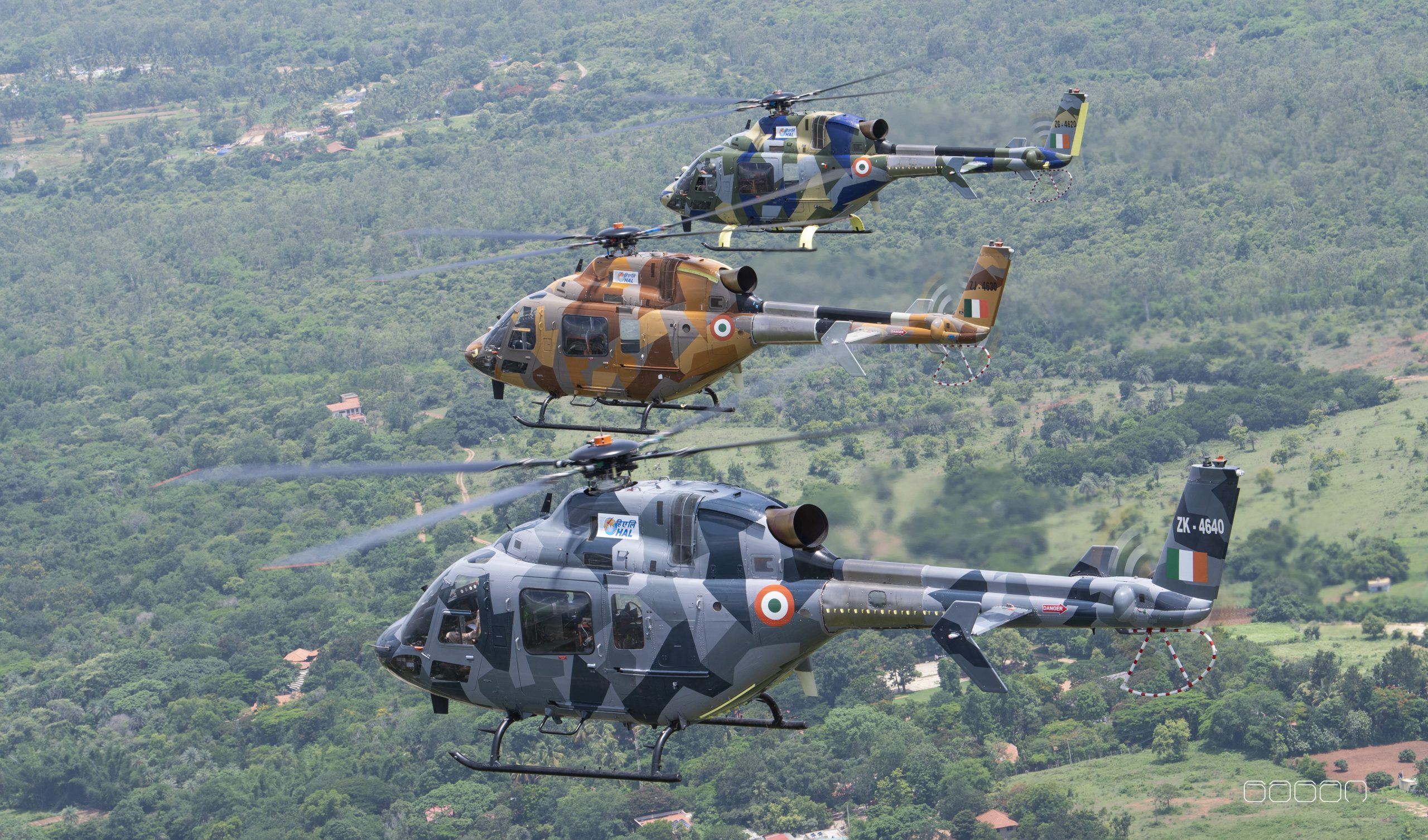Jai Hind future warriors today we are going to talk about the helicopters used by the Indian Army. These helicopters are maintained by the Army Aviation Corps and pilots are also trained by the AAC.

Also Read: How To Join Indian Army Aviation Corps
List of Helicopters used by the Indian Army and They are discussed in the following order
- HAL Cheetah
- HAL LANCER
- HAL Rudra
- HAL Dhruv
- HAL Chetak
- BOEING AE 64 Apache
- HAL Light Utility Helicopter
HAL Cheetah
- The Cheetah helicopter known as Alouette II is a light helicopter originally manufactured by Sud Aviation and later Aérospatiale, both of France.

- The Cheetah is the rechristened Lama which has been derived from the Alouette II. The Lama mated the Alouette’s airframe with the larger Alouette III’s dynamic components including Artouste IIIB engine. On 17 March 1969, the SA315B Lama made its maiden flight. Three years later, on 21 June 1972, Jean Boulet of France, piloting a Lama, broke the high altitude record for a helicopter flight reaching 12,442 meters (40,820 feet), followed by the longest autorotation in history. It is no small testimony to the Lama’s design that the altitude record stands to this day. The Cheetah has been extensively used in the Himalayas, where it is operating at altitudes beyond 20,000 ft and in Siachen it is the backbone of Indian Army’s strategic military presence
- 35 of them are in service and 10 more are being procured on order.
General characteristics
- Crew: 1
- Capacity: 4 passengers or 1,135 kg (2,500 lb) slung payload
- Length: 10.24 m (33 ft 7.25 in)
- Height: 3.09 m (10 ft 1.75 in)
- Empty weight: 1,021 kg (2,251 lb)
- Gross weight: 2,300 kg (5,070 lb)
- Main rotor diameter: 11.02 m (36 ft 1.75 in)
- Main rotor area: 95.38 m2 (1,026 sq ft)
Performance
- Maximum speed: 192 km/h (119 mph, 103 kn)
- Range: 515 km (320 mi, 280 nmi)
- Service ceiling: 5,400 m (17,715 ft)
- Rate of climb: 5.5 m/s (1,080 ft/min)
HAL LANCER
- The LANCER is an armed version of the Cheetah helicopter, equipped with 12.7mm HMG’s (Heavy Machine Gun) and 70 mm rockets. The induction of an aerial weapon platform in the battle array of the Field Force’s Commander has infused the inherent capability for the Aviation to not only ‘look deep’ but also ‘strike deep’. This force multiplier has proved its mettle and is likely to play a pivotal role as part of Combat Aviation resources in undertaking the third dimension manoeuvre strike in the future battle space.

- The helicopter is optimised for anti-insurgency operations, close air support, suppression of enemy fire, attack on vehicular convoys, destruction of enemy machine gun positions and anti-armour applications. It carries two jettisonable combination gun-cum-rocket pods, one each on right and left side on suspension points located on the armament pylon. A gun sight is provided for accurate aiming and firing by the pilot.
HAL Rudra
- The Army’s WSI (Weapon System Integrated) helicopter, is christened as “RUDRA” Synonym for ‘Lord SHIVA’.
- Rudra is a Rigveda God associated with wind or storm or hunt. The name Rudra is taken as a synonym for Lord SHIVA and the two names are used interchangeably. The word is derived from the Sanskrit root ‘ Saru’, which means to injure or to kill and in general sense is interpretive translation of the name ‘sarva’ as ‘one who can kill the forces of darkness’. A different etymology connected with ‘Raudra’ translates as ‘The Fierce God’.
- This agile aerial weapon platform with its sophisticated technology makes it supremely capable of taking ‘Raudra’ form of a ‘Fierce God’ to bring about destruction of the enemy.
- Rudra is the first Army Aviation aircraft to add ‘teeth’ to the fleet of Army Aviation with its Mistral air-to-air missiles, 70 mm rockets, 20 mm guns and ATGMs. The ALH(WSI) is a force multiplier for the field force commander with its potent weapons on board. This helicopter will be able to storm the enemy forces and hunt them down when required. ALH(WSI) pilot will be like an archer who will strike and kill or injure the enemy from a distance. He will be like a fierce God bringing death and destruction to the enemy.
- The first Army Aviation Squadron (WSI) is already under raising and second Army Aviation Squadron (WSI) is planned to be raised thereafter
- 75 of them are in service and 25 more are being procured on order.
General characteristics
- Crew: Two pilots
- Capacity: 12 passengers (14 passengers in high density seating)
- Length: 15.87 m (52 ft 1 in)
- Width: 3.15 m (10 ft 4 in)
- Height: 4.98 m (16 ft 4 in)
- Gross weight: 4,445 kg (9,800 lb)
- Max takeoff weight: 5,800 kg (12,787 lb) for Mk IV
- Main rotor diameter: 13.2 m (43 ft 4 in)
- Main rotor area: 136.85 m2 (1,473.0 sq ft)
Performance
- Maximum speed: 280 km/h (175 mph, 151 kn)
- Cruise speed: 245 km/h (153 mph, 132 kn)
- Never exceed speed: 292 km/h (182 mph, 157 kn) for Mk IV
- Range: 590 km (368 mi, 318 nmi) for Mk IV
- Ferry range: 630 km (394 mi, 340 nmi)
- Endurance: 3.8 hours
- Service ceiling: 6,100 m (20,000 ft) [18]
- Rate of climb: 10.33 m/s (2,033 ft/min)
- Disk loading: 40.19 kg/m2 (8.23 lb/sq ft)
Armament
- 1 × 20 mm M621 cannon on Nexter THL-20 turret
- 2 × 2 Mistral[20]
- 4 × 12 FZ275 LGR[21]
- 4 × 2 Dhruvastra (User trials completed, induction soon.)
Avionics
- Elbit CoMPASS optoelectronic suite for reconnaissance and target acquisition
- RWS-300 radar warning system or LWS-310 laser warning system
- MAW-300 missile approach warning system
- Saab AB IDAS-3 self-protection suite
- BOP-L ECM dispenser
HAL Dhruv
- The ALH (Dhruv) (“Pole Star”) is a multi-role helicopter developed and manufactured by India’s Hindustan Aeronautics Limited (HAL). Military versions inducted in ARMY are for transport, utility, reconnaissance and Casualty -Evacuation roles.

- Design Features: The ALH features a ‘System Bolkow’ four-blade hingeless main rotor with carbon fiber composite blades. The blades have advanced aero foils, swept back tips for reduced nose, and feature a ballistic tolerance against bullet hits of up to 12.7mm caliber. The ALH also features a four axis automatic flight control system, with an integrated control & stability augmentation system from France.
- Airframe: The airframe makes extensive use of composites (Glass Fibre, Carbon and Kevlar) and accounts for 29% of overall structural weight and 60% of surface area. The helicopter design enables the crew to survive vertical impacts of up to 30 feet per second, due to the safety seats and a design of controlled deformation of fuselage crumple zones. The cabin was designed to seat 12 people; however 14 can be accommodated in a high-density configuration. An under slung load hook is standard on army helicopter.
- 109 of them are in service and 95 more are being procured on order.
General characteristics
- Crew: Two pilots
- Capacity: 12 passengers (14 passengers in high density seating)
- Length: 15.87 m (52 ft 1 in)
- Width: 3.15 m (10 ft 4 in)
- Height: 4.98 m (16 ft 4 in)
- Gross weight: 4,445 kg (9,800 lb) for Mk III with wheels
- Max takeoff weight: 5,800 kg (12,787 lb) for Mk III with skids
- Fuel capacity: 1,055 kg (2,326 lb)
- Payload: 1,500 kg (3,300 lb) underslung (Mk II)
- Payload: 1,000 kg (2,200 lb) underslung (Mk III)
- Main rotor diameter: 13.2 m (43 ft 4 in)
- Main rotor area: 136.85 m2 (1,473.0 sq ft)
Performance
- Cruise speed: 250 km/h (155 mph, 135 kn) for Mk III
- Never exceed speed: 291 km/h (181 mph, 157 kn) for Mk III
- Range: 630 km (390 mi, 340 nmi) for Mk III
- Endurance: 3 hours and 42 minutes for Mk III
- Service ceiling: 6,100 m (20,000 ft) [137]
- g limits: 3.5
- Rate of climb: 10.33 m/s (2,033 ft/min)
- Disk loading: 40.19 kg/m2 (8.23 lb/sq ft)
Avionics
- RWS-300 radar warning system or LWS-310 laser warning system
- MAW-300 missile approach warning system
- SAAB IDAS-3 self-protection suite
- BOP-L ECM dispenser
HAL Chetak
- The Chetak (Alouette III) is an enlarged development of the Alouette II series, and was Aerospatiale’s most successful helicopter in terms of numbers built until the mid 1980s.

- The initial SE-3160 Alouette III remained in production for almost a decade until 1969, when it was replaced by the improved SA-316B with strengthened transmission and a greater maximum takeoff weight. This version received FAA Type Approval on 25 March 1971.
- Further development led to the SA-319 Alouette III Astazou, The SA-319 entered production in 1968 as the SA-319B. The sale of Alouette III to India included licence agreements for manufacture of the aircraft in the country. Hindustan (HAL) of India continues to licence build Alouette IIIs as the Chetak (first as SE-3160, later as SA-316B).
- The Chetak continues to be in service with the Army. It is used in a broad spectrum of roles ranging from winching operations, cargo operations, under slung cargo operations, Casualty evacuation, parachute jumps, formation flying and communication sortie.
- 4 of them are in service.
General characteristics
- Crew: 2
- Capacity: 5 passengers
- Length: 10.03 m (32 ft 11 in)
- Height: 3 m (9 ft 10 in)
- Empty weight: 1,143 kg (2,520 lb)
- Gross weight: 2,200 kg (4,850 lb)
- Main rotor diameter: 11.02 m (36 ft 2 in)
- Main rotor area: 95.38 m2 (1,026.7 sq ft)
Performance
- Maximum speed: 210 km/h (130 mph, 110 kn) at sea level
- Cruise speed: 185 km/h (115 mph, 100 kn)
- Range: 540 km (340 mi, 290 nmi)
- Service ceiling: 3,200 m (10,500 ft)
- Rate of climb: 4.3 m/s (850 ft/min)
Helicopters To-Be Acquired Soon
BOEING AH-64E APACHE
In 2020, Boeing signed an agreement with the Government of India for the acquisition of six AH-64E Apache helicopters for the Indian Army. They will soon be added to India’s hangar.

The AH-64E is an advanced multi-mission helicopter with the latest technology insertions, maintaining its standing as the world’s best attack helicopter. It is the only available combat helicopter with a spectrum of capabilities for virtually any mission requirement, including greater thrust and lift, joint digital operability, improved survivability and cognitive decision aiding.
Specifications
- Length: Maximum Level Flight Speed
- Height: 15.24 ft (4.64 m)
- Wing Span: 17.15 ft (5.227 m)
- Primary Mission Gross Weight: 15,075 lb (6,838 kg)
- Vertical Rate of Climb: More than 2,000 ft per minute
- Maximum Rate of Climb: More than 2,800 ft per minute
- Maximum Level Flight Speed: More than 150 knots (279 kilometers per hour).
HAL Light Utility Helicopter
- The HAL Light Utility Helicopter (LUH) along with its derivative Light Observation Helicopter (LOH) was designed and developed by Rotary Wing Research and Design Center, one of the R&D sections of Hindustan Aeronautics Limited (HAL) for civilian and military applications. These are intended to replace Cheetah and Chetak helicopters which are currently in service with Indian Army.
- 6 of them are ordered by the GoI for the Indian Army and will be delivered soon.


General characteristics
- Crew: 2
- Capacity: 6 passengers
- Length: 11.49 m (37 ft 8.25 in)
- Height: 3.38 m (11 ft 1 in) up to the top of the tailfin
- Empty weight: 1,910 kg (4,211 lb)
- Max takeoff weight: 3,150 kg (6,945 lb)
- Main rotor diameter: 11.6 m (38 ft 0.75 in)
Performance
- Maximum speed: 250 km/h (155 mph, 135 kn)
- Cruise speed: 235 km/h (146 mph, 127 kn)
- Never exceed speed: 259 km/h (161 mph, 140 kn)
- Range: 350 km (217 mi, 189 nmi) with 500 kg payload
- Ferry range: 500 km (310 mi, 270 nmi) on internal fuel
- Service ceiling: 6,500 m (21,300 ft)
- Rate of climb: 6.66 m/s (1,426 ft/min
Conclusion
Hope this post was informative for you. For more such posts related to defence exams and SSB Interview stay tuned.
Also Read: List Of Helicopters Used By Indian Air Force
To join the Indian Army as a Helicopter Pilot and crack the SSB Interview, You can join our SSB interview live classes batch and we recommend you to Enroll SSB INTERVIEW ONLINE COURSE. Trusted by thousands of defence aspirants.

















